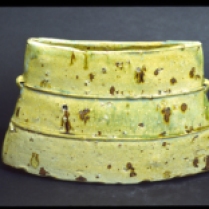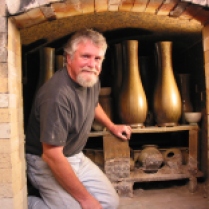By Hideo Mabuchi / Stanford University
One of the neatest features of a Kazegama firing is the opportunity to observe the magic effects of Steve’s “sintered ash” on pot surfaces. The sintered ash is obtained by sieving the largest chunks from a batch of wood ash, and a pile of sintered ash can be used as a refractory bedding under a pot, in place of the usual wadding. Generally the part of the pot that has lain in/near the sintered ash picks striking up blue and even lavender colorations; this can be especially nice for side-fired tall forms like vases, bottles or pitchers. (To see more, go to Firing the Kazegama and scroll down to the “Sintered Ash” paragraph).
After the firing is over one can see that the sintered ash piles often contain some mysterious blue-turquoise grains. The sintered ash itself starts out gray-black like ashy charcoal, and no one seems to have any clear idea of what the blue grains are or how they are formed during the firing.
Earlier today, with help from staff members of the Stanford University Nano Shared Facilities (Drs. Juliet Jamtgaard and Chuck Hitzman), we attempted to analyze the composition of one of these grains using a tool called an X-ray Photoemission Spectrometer—specifically, a PHI VersaProbe Scanning XPS Microprobe located in the Stanford Nanocharacterization Laboratory. This was just a first quick attempt to use this type of tool to get some information about the composition of the grain; it seems like the measurements may have yielded some promising clues but much more study will be necessary before we can draw any firm conclusions.
Here is a picture (taken with an optical microscope) of the grain we examined:
This grain is about a couple of millimeters in dimension. It appears that there is a clear/white part joined to a blue-turquoise part, so we used the PHI VersaProbe to take x-ray photoemission spectra of one patch on the blue part and one patch on the clear part. First here is the spectrum from the clear part:
This spectrum suggests that the primary elemental constituents of the clear part of the grain, at least on its surface, are Carbon, Oxygen and Silicon. So it is tempting to think of this as a simple sort of glass/sand. Next, here is the spectrum from the blue part:
This spectrum suggests that the blue part of the grain distinctively contains Magnesium, Calcium, Potassium and Phosphorous. Note that these elements are all known to be present in wood ash (see, for example, Phil Rogers’ book on Ash Glazes), so this is a plausible analysis. Oxygen and Carbon are again present as well, but if Silicon is still present its signature is too weak to be discerned in this data set.
Could the presence of Magnesium, Calcium, Potassium, and/or Phosphorous explain the blue-turquoise color of the grain? Some possible leads appear if you search the web for images of phosphate minerals. More study is needed—stay tuned…







































